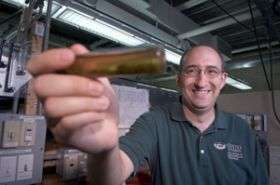Atlanta firm to develop Ohio University algae bioreactor

(PhysOrg.com) -- Atlanta firm Green Bios Technologies has licensed a new type of algae bioreactor from Ohio University developed by internationally renowned engineering professor David Bayless. The company plans to develop the reactor for customers interested in its diverse potential applications, which include curbing air pollution, treating municipal waste, carbon sequestration and growing feedstock for biofuel or pharmaceutical uses.
“Of all the photosynthetic plants out there, algae have the greatest potential to recycle carbon. What makes the idea popular now is the price of oil and biofuels surging,” said Bayless, Loehr Professor of mechanical engineering in the Russ College of Engineering and Technology.
Joe Bajjani, president and CEO of Green Bios Technologies, agreed that algae could have advantages over options such as corn, which has created some problems in the food supply. “It’s cheap. It’s here. We don’t have to import it,” he said.
Bajjani, who is involved in hydraulics manufacturing in the United States and Europe, first read about the Bayless bioreactor in July 2007 and was excited about its potential.
“It was obvious (Bayless) was on to something,” he said. “We feel strongly we can commercialize this and have a working model in a very short period of time.”
The current model of the bioreactor is an upright pipe about 5 feet tall and 4 inches wide. Algae inside the pipe feed on a running stream of water carbonated with CO2. However, there are proprietary aspects to the bioreactor that make it very different from other technologies currently on the market.
Green Bios Technologies and Bayless will design a larger, commercial-scale version of the bioreactor within the next 12 months. The technology has several potential applications. Companies could use the bioreactor to mitigate CO2 emissions, city governments could use the invention for municipal waste treatment and water reclamation and entrepreneurs could use it to grow their own algae for biomass and fuels.
“If they can buy something off the shelf, it will save them time and effort,” Bayless said.
There are several bioreactors already on the market, but they haven’t worked as well as anticipated, Bajjani said. The professional engineers who have reviewed the Bayless design think that he may have overcome those problems, he noted.
Bayless hopes that the successful commercialization of the algae bioreactor will provide more proof that the little green plant could be a useful tool in solving current problems in energy and the environment.
“If we make small steps and enjoy a chain of successes,” he said, “we’ll see an algae industry grow.”
The algae bioreactor is one of several technologies Ohio University has licensed in recent years, according to Lisa Rooney, director of the Technology Transfer Office. In fiscal 2008, the institution reported $5.9 million in revenue from several existing licenses, including a drug for a growth hormone disorder and technologies for air pollution mitigation and alternative energy production.
Provided by Ohio University





















